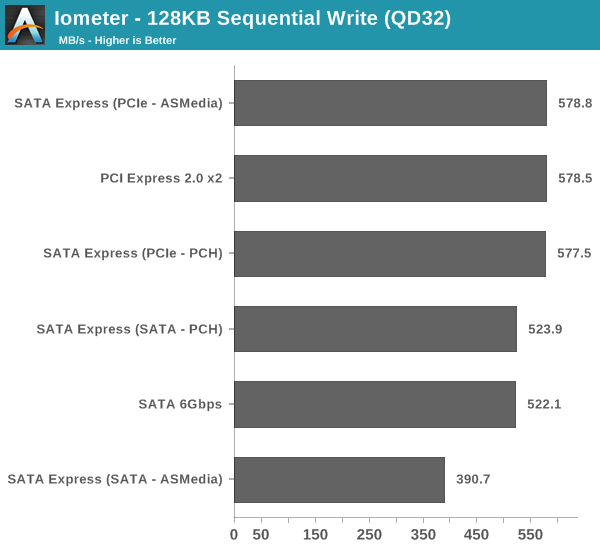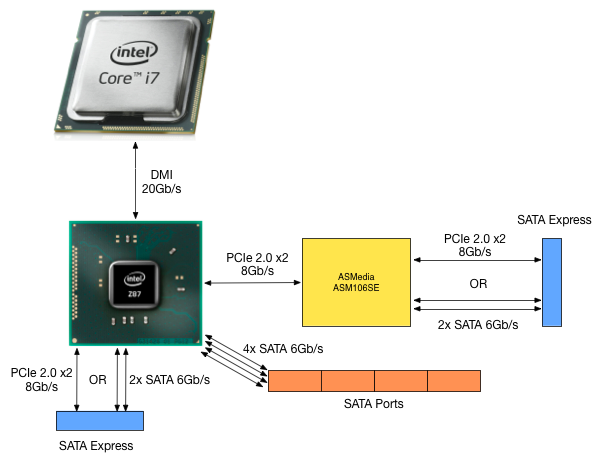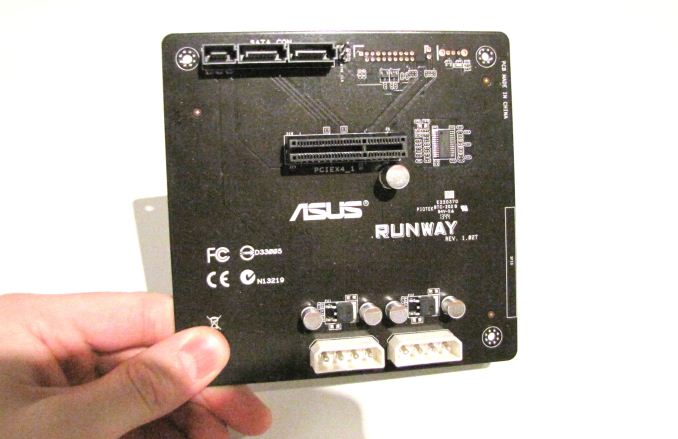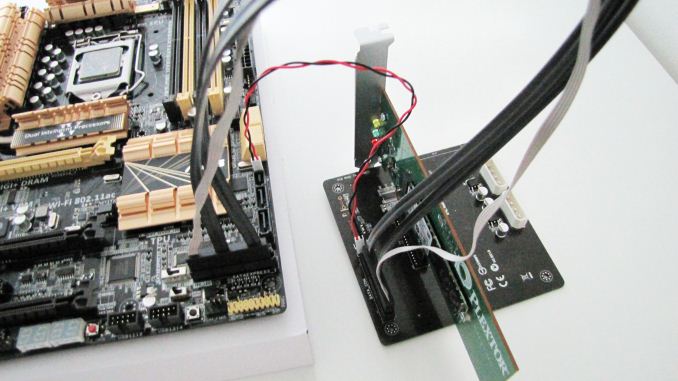Testing SATA Express And Why We Need Faster SSDs
by Kristian Vättö on March 13, 2014 7:00 AM EST- Posted in
- Storage
- SSDs
- Asus
- SATA
- SATA Express
Testing SATA Express
SATAe is not commercially available yet but ASUS sent us a pre-production unit of the SATA Express version of their Z87 Deluxe motherboard along with the necessary peripherals to test SATAe. This is actually the same motherboard as our 2014 SSD testbed but with added SATAe functionality.
| Test Setup | |
| CPU | Intel Core i7-4770K at 3.5GHz (Turbo & EIST enabled, C-states disabled) |
| Motherboard | ASUS Z87 Deluxe SATA Express (BIOS 1707) |
| Chipset | Intel Z87 |
| Chipset Drivers | 9.4.0.1026 |
| Storage Drivers | Intel RST 12.9.0.1001 |
| Memory | Corsair Vengeance DDR3-1866 2x8GB (9-10-9-27 2T) |
| Graphics | Intel HD Graphics 4600 |
| Graphics Drivers | 15.33.8.64.3345 |
| Power Supply | Corsair RM750 |
| OS | Windows 7 Ultimate 64-bit |
Before we get into the actual tests, we would like to thank the following companies for helping us with our 2014 SSD testbed.
- Thanks to Intel for the Core i7-4770K CPU
- Thanks to ASUS for the Z87 Deluxe motherboard
- Thanks to Corsair for the Vengeance 16GB DDR3-1866 DRAM kit, RM750 power supply, Hydro H60 CPU cooler and Carbide 330R case
The ASUS Z87 Deluxe SATA Express has two SATAe ports: one routed from the Platform Controller Hub (PCH) and the other provided by an ASMedia ASM106SE chip. The ASMedia is an unreleased chip, hence there is no information to be found about it and ASUS is very tight-lipped about the whole thing. I'm guessing we are dealing with the same SATA 6Gbps design as other ASM106x chips but with added PCIe pass-through functionality to make the chip suitable for SATA Express.
I did a quick block diagram that shows the storage side of the ASUS SATAe board we have. Basically there are four lanes in total dedicated to SATAe with support for up to two SATAe drives in addition to four SATA 6Gbps devices. Alternatively you can have up to eight SATA 6Gbps devices if neither of the SATAe ports is operating in PCIe mode.
Since there are no SATAe drives available at this point, ASUS sent us a SATAe demo daughterboard along with the motherboard. The daughterboard itself is very simple: it has the same SATAe connector as found in the motherboard, two molex power inputs, a clock cable header, and a PCIe slot.
This is what the setup looks like in action (though as you can see, I took the motherboard out of the case since inside case photos didn't turn out so well with the poor camera I have). The black and red cable is the external clock cable, which is only temporary and won't be needed with a final SATAe board.
The Tests
For testing I used Plextor's 256GB M6e PCIe SSD, which is a PCIe 2.0 x2 SSD with Marvell's new 88SS9183 PCIe controller. Plextor rates the M6e at up to 770MB/s read and 580MB/s write, so we should be capable of reaching the full potential of PCIe 2.0 x2. Additionally I tested the SATA 6Gbps ports with a 256GB OCZ Vertex 450. I used the same sequential 128KB Iometer tests that we use in our SSD reviews but I ramped up the queue depth to 32 to make sure we are looking at a maximum throughput situation.

There is no practical difference between a PCIe slot on the motherboard and PCIe that is routed through SATA Express. I'm a little surprised that there is absolutely no hit in performance (other than a negligible 1.5MB/s that's basically within the margin of error) because after all we are using cabling that should add latency. It seems that SATA-IO has been able to make the cabling efficient enough to transmit PCIe without additional overhead.
As for SATA 6Gbps, the performance is the same as well, which isn't surprising since only the connector is slightly different while electrically everything is the same. With the ASMedia chipset there is ~25-27% reduction in performance but that is inline with the previous ASMedia SATA 6Gbps chipsets I've seen. As I mentioned earlier, I doubt that the ASM106SE brings anything new to the SATA side of the controller and that's why I wasn't expecting more than 400MB/s. Generally you'll only get full SATA bandwidth from an Intel chipset or a higher-end SATA/RAID card.

The same goes for write performance. The only case where you are going to see a difference is if you connect to the ASMedia SATA 6Gbps port. I did run some additional benchmarks (like our performance consistency test) to see if a different workload would yield different results but all my tests showed that SATAe in PCIe mode is as fast as a real PCIe slot, so I'm not going to post a bunch additional graphs showing that the two are equivalent.













131 Comments
View All Comments
mkozakewich - Friday, March 14, 2014 - link
Ooh, or what if we had actual M.2 slots on desktop motherboards that could take a ribbon to attach 2.5" PCIe SSDs?phoenix_rizzen - Thursday, March 13, 2014 - link
Yeah. Seems strange that they wouldn't re-use the M.2 or mSATA connector for this. Why take up 2 complete SATA slots, and add an extra connector? What are they doing with the SATA connectors when running in SATAe mode?It amost would have made sense to make a cable that plugged into <whatever> at the drive end, and just slotted into a PCIe x1 or x2 or x4 slot on the mobo. Skipped the dedicated slot entirely. Then they wouldn't need that hokey power dongle off the drive connector.
frenchy_2001 - Friday, March 14, 2014 - link
They were looking for backward compatibility with current storage and in that context, the decision makes sense. No need to think about how to plug it, it just slots right where the rest of the storage goes and can even accept its predecessor.It's a desktop/server/storage centric product, not really meant for laptop/portable.
But I agree its place is becoming squished between full PCIe (used already in data centers) and miniPCIe/M2 used in portables. As the requirement is already 2x PCIe lanes (like the others), it will be hard to use for lots of storage and if you cannot fit 24 of those in a rack (which is how most server use SATA/SAS), as few servers have 48 lanes of PCIe hanging around unused then it seems only reserved to desktop/workstation and those can easily use PCIe storage...
phoenix_rizzen - Friday, March 14, 2014 - link
Yeah, until you try to connect more than 2 of those to a motherboard. And good luck getting that to work on a mini-ATX/micro-ATX board. Why use up two whole SATA ports, and still use an extra port for PCIe side of it?How are you going to make add-in controller cards for 4+ drives? There's no room for 4 of those connectors anywhere. And trying to do a multi-lane setup like SFF-8087 for this will be rediculous.
The connector is dumb, no matter how you look at it. Especially since it doesn't support power.
jasonelmore - Saturday, March 15, 2014 - link
it looks like the only reason to be excited about this connector is for using older Hard Drives 2.5 or 3.5 form factor, and putting them on a faster bus.Other than that, other solutions exist and they do it quicker and with less power. its just a solution to let people use old hardware longer.
phobos512 - Thursday, March 13, 2014 - link
It's not an assumption. The cabling adds distance to the signal path, which increases latency. Electrons don't travel at infinite speed; merely the speed of light (in a vacuum; in a cable it is of course reduced).ddriver - Thursday, March 13, 2014 - link
You might be surprised now negligible the effect of the speed of electrons is for the total overall latency.Khenglish - Thursday, March 13, 2014 - link
It's negligible.The worst cables carry a signal at 66% of the speed of light, with the best over 90%. If we take the worst case scenario of 66% we get this:
speed of light = 3*10^8 m/s
1m / (.66 * 3*10^8 m/s) = 5ns per meter
If we have a really long 5m cable that's 25ns. Kristian says it takes 115us to read a page. You never read less than 1 page at a time.
25ns/115us = .0217% for a long 5m cable. Completely insignificant latency impact.
willis936 - Thursday, March 13, 2014 - link
The real latency number to look at is the one cited on the nvme page: 2.8us. It's not so negligible then. It does affect control overhead a good deal.Also I have a practical concern of channel loss. You can't just slap a pcie lane onto a 1m cable. Pcie is designed to ride a vein of traces straight to a socket, straight to a card. You're now increasing the length of those traces, still putting it through a socket, and now putting it through a long, low cost cable. Asking more than 1.5GB/s might not work as planned going forward.
DanNeely - Thursday, March 13, 2014 - link
Actually you can. Pcie cabling has been part of the spec since 2007; and while there isn't an explicit max length in the spec, at least one vendor is selling pcie2.0 cables that are up to 7m long for passive versions and 25m for active copper cables. Fiberoptic 3.0 cables are available to 300m.